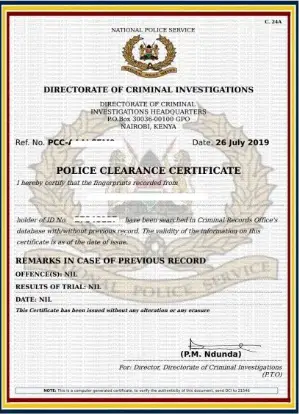Have you ever wondered how to safeguard your beloved motor vehicle in Kenya from unauthorized transfers? Well, you’re in luck because there’s a handy solution known as a “caveat.”
In this article, we’re going to walk you through the process of placing a caveat on your motor vehicle to prevent it from changing hands without your consent.
Whether you’re an individual looking to protect your car or a government agency conducting an investigation, we’ve got you covered.
What is a Caveat?
A caveat is like a temporary ‘keep-out’ sign for your motor vehicle. It’s a restriction that you can place on your car to ensure it can’t be transferred to someone else without your knowledge and consent.
Think of it as a security measure that can save you from unwanted surprises involving your vehicle.
Grounds for Placing a Caveat
Now that you understand what a caveat is, let’s dive into the various reasons or “grounds” for placing one on your motor vehicle.
1. Valid Court Orders: When Justice Demands a Caveat
Have you obtained a valid court order? If so, you have a solid reason to place a caveat on your vehicle. This could be related to various legal matters where the court has ruled in your favor and you want to protect your assets from potential disputes.
2. Request by Government Agencies: The Investigative Phase
Are government agencies like the DCI, KRA, or EACC conducting an investigation related to your vehicle? If that’s the case, they can request a caveat on your vehicle. However, this type of caveat is temporary, lasting only 14 days while the investigative agencies seek a court order.
3. Spousal Request: Protecting Family Assets
Are you married, and is your spouse concerned about the ownership of your motor vehicle due to specific life events, such as death, insanity, or incapacitation? In such cases, your spouse can request a caveat with the support of a marriage certificate to safeguard the vehicle.
4. Legal Representatives: Advocates in Action
Do you have a legal representative, such as an advocate, acting on your behalf? If so, they can place a caveat on your motor vehicle, provided they have the necessary authorization.
5. Administrator of Deceased Owner’s Property: Honoring Legacies
If the registered owner of the motor vehicle is deceased, and an administrator has been appointed for their property, they can place a caveat to safeguard the vehicle.
6. Administrative Caveat: Guarding Against Fraud
Suspect a fraudulent transaction involving your vehicle? In such cases, the National Transport & Safety Authority can authorize an administrative caveat to protect your interests.
Requirements for Placing a Caveat
Now that you know the reasons for placing a caveat, let’s explore what you need to actually do it. Whether you’re an individual or a government agency, certain requirements must be met.
Individual Requirements
Request Letter: Putting It in Writing
To initiate the process, you’ll need to submit a formal request letter. This letter should clearly state the grounds for placing the caveat and provide essential details about your situation.
ID: Proving Your Identity
Naturally, you’ll also need to provide identification to confirm your identity as the vehicle owner or authorized representative.
Government Agencies Requirements
Request Letter: The Official Request
Government agencies seeking to place a caveat must also submit an official request letter, outlining the reasons for the caveat.
Court Order: The Legal Foundation
In some cases, government agencies might need a court order to proceed with the caveat. This court order serves as the legal basis for placing the restriction.
Once you’ve gathered all the necessary documents, it’s time to take action.
Placing a Caveat: Step-by-Step Guide
Let’s break down the process of placing a caveat on your motor vehicle.
Step 1: Prepare Your Request Letter
As an individual or government agency, you’ll need to draft a request letter. Make sure it’s clear, concise, and includes all the relevant details.
Step 2: Gather Supporting Documents
Collect any additional required documents, such as a marriage certificate, court order, or legal authorization, depending on your specific situation.
Step 3: Visit Your Nearest NTSA Office
Take your request letter, supporting documents, and ID to the nearest National Transport & Safety Authority (NTSA) office. This is where you’ll submit your application.
Step 4: Wait for Processing
The NTSA will process your request within two working days. During this time, they’ll review your documents and assess the validity of your request.
Step 5: Confirmation and Caveat Placement
Once approved, the NTSA will place the caveat on your motor vehicle. You’ll receive confirmation of the caveat placement.
Charges and Timelines
The best part about placing a caveat? It’s absolutely free! That’s right; you won’t incur any charges during this process.
As for the timeline, you can expect the entire process, from submission to the placement of the caveat, to take just two working days. It’s a quick and hassle-free way to secure your vehicle.
Lifting a Caveat
Now that your motor vehicle has a caveat in place, it’s essential to know how to remove it when the time comes.
Who Can Lift a Caveat?
A caveat can only be lifted by the person or agency that placed it, or through a court order. Let’s explore the requirements and procedures for both scenarios.
Individual Requirements for Lifting a Caveat
Request Letter: Expressing Your Intent
To lift the caveat on your vehicle, you’ll need to submit a request letter expressing your intent clearly.
ID: Confirming Your Identity
Just as when placing the caveat, you’ll need to provide identification to prove your identity.
Government Agencies Requirements for Lifting a Caveat
Request Letter: The Official Request
Government agencies seeking to lift a caveat must submit an official request letter, indicating the reasons for the removal.
Court Order: When Legal Action is Required
In some cases, government agencies might need a court order to lift the caveat, especially if it was initially placed with the support of a court order.
The Lifting Process
Now, let’s walk through the process of lifting a caveat.
Step 1: Prepare Your Request Letter
Draft a request letter indicating your intent to lift the caveat. Be sure to include all the necessary details.
Step 2: Collect Required Documents
Gather any supporting documents, such as a court order or legal authorization, as applicable to your situation.
Step 3: Visit the NTSA Office
Head over to your nearest National Transport & Safety Authority (NTSA) office, just like when you placed the caveat. Submit your request letter, supporting documents, and ID.
Step 4: Await Processing
The NTSA will process your request within two working days. During this time, they’ll review your documents to determine whether the conditions for lifting the caveat have been met.
Step 5: Confirmation and Caveat Removal
Upon approval, the NTSA will proceed to lift the caveat from your motor vehicle. You’ll receive confirmation that the caveat has been successfully removed.
Charges and Timelines for Lifting a Caveat
Good news – lifting a caveat is also free of charge! You won’t need to pay any fees for the removal process.
In terms of timing, you can expect the entire process to take just two working days, just like when placing the caveat. It’s a smooth and efficient process designed to ensure your assets are protected promptly.
Conclusion
In a world where assets like motor vehicles are valuable and sometimes subject to disputes or fraudulent activities, knowing how to place and lift a caveat is a valuable skill.
Whether you’re an individual protecting your beloved car or a government agency safeguarding interests during an investigation, the process is straightforward and free of charge.
By understanding the grounds for placing a caveat, meeting the necessary requirements, and following the step-by-step procedures, you can ensure that your motor vehicle remains secure and under your control. It’s a legal safeguard that offers peace of mind in a world full of uncertainties.
So, if you ever find yourself in a situation where you need to take action to protect your motor vehicle, remember the power of the caveat – your trusty ‘keep-out’ sign in the world of automobiles.



